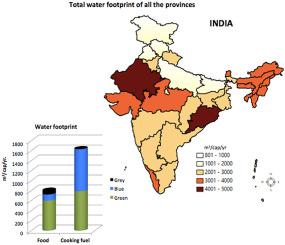当前位置:
X-MOL 学术
›
J. Clean. Prod.
›
论文详情
Our official English website, www.x-mol.net, welcomes your
feedback! (Note: you will need to create a separate account there.)
The water footprint of food and cooking fuel: A case study of self-sufficient rural India
Journal of Cleaner Production ( IF 9.7 ) Pub Date : 2020-11-24 , DOI: 10.1016/j.jclepro.2020.125255 K. Das , P.W. Gerbens-Leenes , S. Nonhebel
Journal of Cleaner Production ( IF 9.7 ) Pub Date : 2020-11-24 , DOI: 10.1016/j.jclepro.2020.125255 K. Das , P.W. Gerbens-Leenes , S. Nonhebel

|
Water is a basic resource for food and fuelwood production. In general, people in rural areas of India consume carbohydrate rich staples with small amounts of animal foods. They mostly depend upon fuelwood for cooking. This study assesses the WFs for food and fuel consumption in rural India. The research question is: What is the green, blue and grey water footprint (WF) of food and cooking fuel consumption per province in rural India (m/cap/year). It used the WF method for the quantification. Data on food and fuelwood consumption were derived from the National Sample Survey (2011–12). Foods were categorized into 6 groups: 1. ; 2. ; 3. ; 4; 5; and 6. . Cooking fuel includes: 1. ; 2. and 3. . Data related to WFs of food were derived from literature reviews and in case of fuelwood, the WFs were calculated for all the provinces of India. Finally, the total WF of per capita consumption is calculated by adding the WF of food and fuelwood. The result shows that there is a large variation in the green, blue and grey WFs for food consumption across the provinces of India. The average WF for food consumption is about 800 m/cap/year and for fuelwood is 1630 m/cap/year. Rice and wheat dominate the green, blue and grey WFs for food, with variations among the provinces. The green WF of rice is larger than the green WF of wheat, while wheat has a larger blue WF. For cooking fuel, the average WF of fuelwood is much larger than the WF of fossil based cooking fuels. The total WF for fuelwood is twice the WF for food, showing that in rural areas of developing countries, fuelwood is water intensive with large impact on freshwater resources. Future prospects of increasing consumption of animal products will increase WFs. However, if also cooking fuel is considered, switching to fossil cooking fuel lowers WFs far more and compensates the increase due to larger animal food consumption. The trends for cooking fuel found in India might also be relevant for other developing countries.
更新日期:2020-11-24











































 京公网安备 11010802027423号
京公网安备 11010802027423号